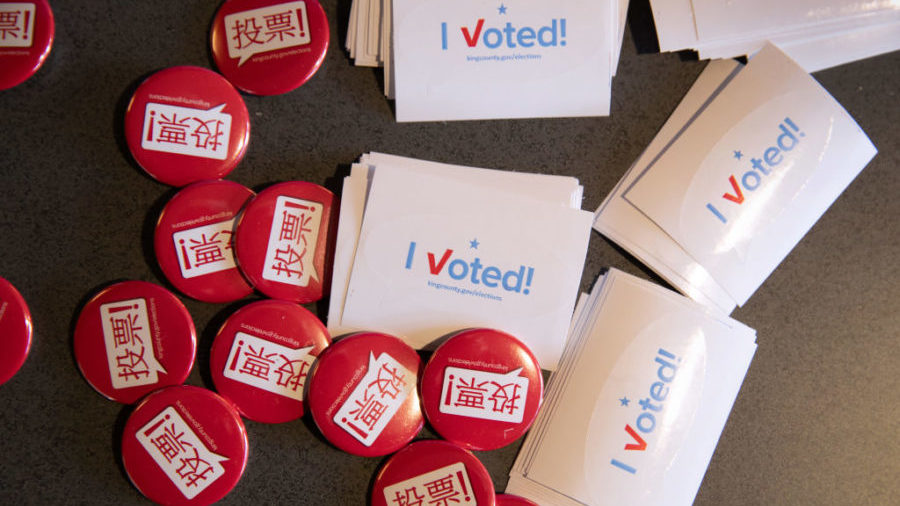How a napkin can be counted as a vote in Washington, and why election officials say it’s secure
Nov 17, 2021, 2:05 PM | Updated: Nov 18, 2021, 8:35 am

Voting pins and stickers lie next to a ballot box at the King County Elections processing center in Renton, Washington. (Photo by John Moore/Getty Images)
(Photo by John Moore/Getty Images)
A story surfaced this week, detailing a video where a King County Elections official described a scenario where a napkin indicating a voter’s choice could be accepted in lieu of an official ballot. Washington Secretary of State Kim Wyman and a spokesperson for King County Elections (KCE) spoke to 成人X站 Radio’s Dori Monson Show and MyNorthwest to explain why that is.
Dori: Why use a ballot to vote when you can use a napkin?
Washington follows what are known as “voter intent” rules, meaning “that voters are not disenfranchised if they mark their ballot differently than directed,” King County Elections spokesperson Halei Watkins told MyNorthwest.
“If the voter鈥檚 intent is clear, their vote can be counted,” she clarified.
In the case of the video circulated by the Post Millennial, the exchange regarding the napkin scenario was part of a Canvassing Board meeting . In it, a board member detailed how a voter could hypothetically take a napkin, write in the race and office they’re voting for, mark their selection, and have that be officially counted, provided that it’s returned in the signed envelope distributed by KCE.
As Wyman notes, there are a series of built-in fail-safes to ensure the validity of that process once the envelope arrives at an election office.
“Remember, at that point, they’ve already verified the signature for the voter against someone on file, they’ve already validated that that person hasn’t voted more than once, and that they were eligible to participate in the election,” she told 成人X站 Radio’s Dori Monson Show. “By the time we get to the ballot, that voter is eligible to participate.”
There’s an added layer of security as well, ensuring that no single election worker is ever alone during the ballot tallying process, so that “you never [have] that opportunity for a single person to be making those value judgments of, ‘oh, I don’t like the way they voted.'”
Ross: No cries of vote fraud, except maybe one case in Seattle
“Each of those steps along the process, we are accounting for every envelope we received against the computer tallies that we’re doing on multiple levels,” Wyman detailed, likening the process to how banks account for their money on any given day. “There’s no single point where those things can happen where it wouldn’t be detected.”
Instances where a vote arrives in the form of a napkin, a piece of scratch paper, or anything other than an official ballot are described by Watkins as “pretty rare.” When they do occur, the decision on how to proceed falls to the local Canvassing Board, comprised of KCE Director Julie Wise, and representatives from both the King County Council and the county Prosecutor’s Office.
“They review and make determinations on any cases where voter intent is not clear to staff under the guidelines in the (Secretary of State’s) ,” Watkins said. “We typically hold 1-2 Canvassing Board meetings each election prior to certification where the Board will review all outstanding materials or questions and then direct staff to process those based on their determination.”














